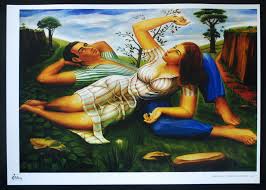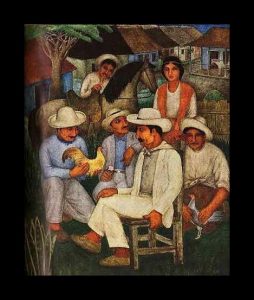CUBAN ART
Our experience of the Cuban art world began at the Museo de Arte Colonial whose collection of colonial furniture and decorative arts was appropriately displayed in a beautifully restored 1720 mansion. We wandered from room to room admiring the treasures, as though we were guests in a private home. The museum was truly like a hidden secret known to just a handful of visitors, who were greatly out-numbered by eager curators with their animated knowledge of colonial art.
Likewise, the vast museum of fine arts (Museo Nacional de Bellas Artes) was incredibly quiet the morning we viewed its impressive collection of Cuban art. The museum is housed in the Palacio de Bellas Artes, albeit far from palatial being built in 1954, thus mid-century modern in style, i.e. rectilinear/curvilinear concrete.
The art collection is mostly that of 20th century local artists. Their work conveys the impassioned social message of the Cuban vanguard movement, promoting the rights of the rural poor versus the ruling elite. These artists were very much influenced by their diverse heritage – African, European, American and Asian – as well as the modernism (surrealism, cubism and primitivism) that they had embraced when travelling further afield to Europe, encountering the likes of Picasso, Matisse, Gauguin and Dali amongst others.
 |
| El Terco Mundo |
One such artist, whose work caught my attention, was Wifredo Lam (1902-1982). His unique style echoes the spirit of the Afro-Cuban culture and was equally inspired by some of the most renowned artists of the 20th century. Lam’s work reveals his desire to paint what he considered to be the real Cuba ‘beyond cha-cha-cha … to paint the drama of the country … by expressing the negro spirit … like a Trojan horse … to disturb the dreams of the exploiters …’.
This is highlighted in Lam’s ‘Jungle’, which is often compared to Picasso’s ‘Guernica’ (exhibited in MOMA, NYC), and we could equally see his message in ‘El Tercer Mundo’ (Third World) where the haphazard human-like forms create a macabre scene of starving underclasses.
In sharp contrast, the bold hues of works by renowned muralist Amelia Peláez (1896-1968) attractively portray still life. I was rather impressed by her Cuban women and her colourful portrayal of the popular political activist José Marti, recognised by his distinctive moustache.
 |
| José Marti |
 |
| Las Mujeres |
 |
| Landscape of Havana |
The collage-like ‘Landscape of Havana’ by René Portocarrero (1912 – 1985) is one of a series of ‘cityscapes’, whose intricate details and multi-coloured palette are an eye-catching representation of Havana.
Conversely, the intertwined sweeping brush strokes of the dramatic ‘Rapto de las Mulatas’ (Rape of the Mulatas) by Carlos Enriquez (1900 – 1957) illustrate and emphasize the violent scene, reminiscent of the mythical ‘Rape of the Sabine Women’. The ironically entitled ‘Campesinos Felices’ (Happy Peasants) by Enriquez dares to criticize Batista’s repressive régime of the 30s, revealing the misery of the impoverished Cuban peasants, comparable to the horror of Edvard Munch’s ‘The Scream’.
 |
| Rapto de las Mulatas |
 |
| Campesinos Felices |
A less macabre more cheerful favourite was ‘La Gitana Tropical’(The Tropical Gipsy) by Victor Manuel (1897 – 1969), otherwise known as ‘La Gioconda Americana’ (The American Mona Lisa).
 |
| Primavera o Descanso |
 |
| La Gitana Tropical |
The elongated rounded limbs in ‘Primavera o Descanso’ (Spring or Rest), by Jorge Arche (1905 – 1956), clearly show that this principally self-taught artist was influenced by the masters – from Raphael and Modigliani to Diego Rivera.
 |
| Guajiros |
‘Guajiros’ (Farmers), by comic artist Edouardo Abela (1902 – 1982), equally shows a style influenced by Mexican muralists and renaissance artists.
The striking and relatively recent pop art of Raul Martínez (1927 – 1995) colourfully depicts Cuban culture and social transformation, versus material consumerism normally associated with this art genre. Martínez’s work features political leaders (‘Rosas y Estrellas’ – Stars and Roses) alongside people from everyday life, such as Cuban laborers and his own friends and acquaintances.
 |
| Rosas y Estrellas |
Following the Cuban revolution (1953-59), the restrictions imposed by the new Castro government led to a mass exodus of intellectuals and artists from Cuba. However, those left behind were in fact offered financial support by the government, provided they promoted the prevailing political standpoint. Following the loss of Soviet support in 1989, and the subsequent ‘Special Period’ (a euphemism for Cuba’s economic crisis), the Cuban government began programmes to stimulate the tourist trade, which consequently gave art more visibility.
Artists began to express their feelings and emotions about themselves versus politics and society. This revolutionised the Cuban art world, whereby the predominant Conceptual art (where the idea or concept behind the work is more important than the finished art object) was replaced by Figurative art – any form of modern art that retains strong references to the real world, particularly to the human figure. This was certainly a catalyst for freedom of expression.
‘Every Cuban is an artist and every home is an art gallery’ wrote Rachel Weiss in ‘To and from Utopia in the New Cuban Art’.
This was very much apparent when wandering around the little side streets in Old Havana, where open doorways were commonplace, either for reasons of sociability or to welcome passers-by into a private art studio/gallery. ‘Estudio de Pintura Martalena’ lured us with its brightly coloured works of art adorning the exterior walls of what then appeared to be Martalena’s home and art gallery. Her vast repertoire included many self-portraits, featuring images of Frida Kahlo, appearing like Martalena’s alter ego.
 |
| Estudio de Pintura Martalena |
Another artist, Pablo Avila, and his wife Marta, warmly greeted us like guests visiting their own home. Their gallery displayed a selection of Pablo’s work alongside that of various Cuban artists.
Pablo happened to be giving an English lesson to two redheaded students – models versus painters – whose stunning looks are undoubtedly the subject of many a painting.
Freedom of expression was certainly at its height at ‘Fabrica de Arte Cubano’ where provocative works of art adorned the vast former factory walls. The daring repertoire of Argentinian born Israeli and Cuba resident, Enrique Rottenberg, was very much exemplary of his style, considered to be ‘controversial, satirical, manic-melancholic, lewd, empathic, alarming’.
Rottenberg’s recent work, entitled ‘Utopia’, consists of photo installations depicting marginalised minorities, which he represents in the ironically entitled ‘Men of Color’.
Modern Cuban art visibly reflects the general thoughts and feelings of Cuban society at large – their transition from years of suppression to a new found freedom, with great hope for a brighter future.





